Epidemiology of cervical cancer in Latin America
Luis G Capote Negrin
Clínica Luis Razetti, Consultorio 65, Av Este con Calle Sur 21, Candelaria, Caracas, 1010, Venezuela
Correspondence to: Luis G Capote Negrin. Email: lcapote@mpps.gob.ve
Abstract
The basic aspects of the descriptive epidemiology of cervical cancer in Latin America are presented. A decrease in the incidence and mortality rates has been observed in the period from 2000 to 2012 in all countries across the region, this has not occurred at the same proportions, and in many countries, observed figures of incidence and mortality are among the highest levels in the world. In Latin America, calculating a mean measure of the numbers from the GLOBOCAN data from 2000 to 2012, we can observe a difference of up to fivefold of the incidence (Puerto Rico 9,73 Vs Bolivia 50,73) and almost seven times for mortality (Puerto Rico 3,3 Vs Nicaragua 21,67).
A report of the epidemiology, risk factors, and evaluation of screening procedures regarding the possible impact of the human papillomavirus (HPV) vaccine I in the prevention of cervical cancer is presented.
Keywords: cervical cancer, Latin America, human papillovirus (HPV)
Copyright: © the authors; licensee ecancermedicalscience. This is an Open Access article distributed under the terms of the Creative Commons Attribution License (http://creativecommons.org/licenses/by/3.0), which permits unrestricted use, distribution, and reproduction in any medium, provided the original work is properly cited.
Published: 08/10/2015; Received: 12/01/2015
Introduction
Cervical cancer remains the number one cause of mortality due to malignant neoplasm among 20 to 40-year-old women in Latin America, and the third most common cause of cancer death in females, second only to breast cancer and lung cancer.
In a recent study, the World Health Organisation (WHO) admitted that as many as 529,409 women worldwide will be diagnosed with cervical cancer, and 274,883 will die from the disease. No less than 80% of this burden is borne in less developed countries [1].
In America, it is estimated that there are around 92,136 cases and 37,640 deaths per year, representing a significant economic loss, projected at being potentially greater than US$ 3,6 billion [2].
This is a pathology that has been recognised for more than 50 years as being a disease linked to the sexual habits of women or their partners [3, 4, 5] and furthermore whose incidence clearly disproportionately impacts women from the poorest social strata, and the most economically disadvantaged regions [6]; to the extent that mortality rates from this cancer are three times higher in Latin America and the Caribbean than in the United States and Canada [2].
The variations between countries in the region, for the period from 2000 to 2012, taken from the GLOBOCAN reports [7], show a difference in the rates, standardised per 100,000 women, of up to five times the incidence (Puerto Rico 9.73 v Bolivia 50.73) and almost seven times the mortality (Puerto Rico 3.3 v Nicaragua 21.67). These differences are more strongly linked to unequal access to control measures than as a consequence of differences in the sexual conduct of the populations.
Descriptive aspects of cervical cancer in Latin America
It is useful to draw comparisons with data on the global incidence of cervical cancer. Figures 1 and 2 show the specific distribution, which has led to the development of cervical cancer known as third most common cancer worldwide. Economically better off regions clearly show lower rates, with notable exceptions in North Africa, the Arabian Peninsula, and some near Asian areas, which while they are not part of the most economically developed areas of the world, show low rates, possibly due to the up keep of religious mores favouring conservative sexual conduct; a similar observation was presented by Drain et al in a work analysing determinants of cervical cancer rates in underdeveloped countries [8].

Figure 1. Cervical cancer around the world. Estimated mortality rates.
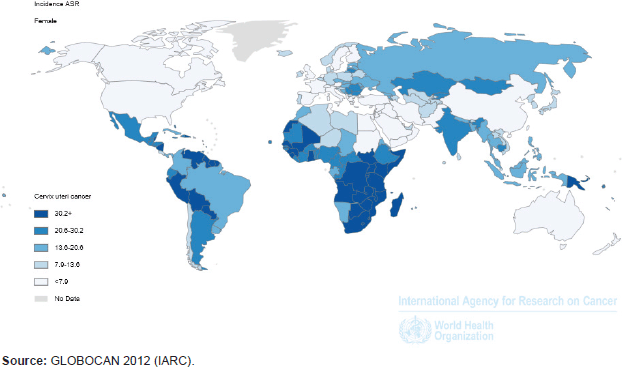
Figure 2. Cervical cancer around the world. Estimated incidence rates.
In Latin America, cervical cancer puts an enormous strain on the health system [2], presenting as the third most common cause of female cancer death, second only to lung and breast cancer; although in some countries, such as Honduras, Nicaragua, El Salvador, Bolivia, Paraguay, and Ecuador, it remains the principal cause of female cancer deaths. Nonetheless, it is one of the most preventable and curable forms of cancer, as shown by cancer statistics from developed countries.
In Latin America for 2012, almost 70,000 cases and 28,000 deaths from cervical cancer occurred, according to information compiled from GLOBOCAN data [7].
The Pan American Health Organisation estimate for 2012 was around 36,000 deaths from this type of cancer across America with 80% of these deaths relating to Latin America and the Caribbean www.paho.org/cancer/cervicalcancer [9].
The descriptive epidemiological method is a valuable tool when referring to the social behaviour of disease, especially in relation to chronological trends, geographical distribution or individual factors.
This article is limited to those basically descriptive aspects of the epidemiology of cervical cancer in Latin America, as well as to understand its natural history and the evaluation of screening procedures and the possible impact of the vaccine against human papillomavirus (HPV), as a contribution to the understanding and control of the disease.
Evaluation of chronological trends and geographical distribution of cervical cancer, observed between 2000 and 2012, shows a reduction in mortality in absolute terms, from 31,000 deaths in 2000 to 28,000 in 2012 [7]. This trend is obviously not proportionally distributed, and while in the majority of countries, there has been a reduction in mortality, but mortality rate increases in some countries.
To better appreciate the real variation in risk, we measure it using one indicator, such as the standardised rate, which takes into account the population structure by age group and as a benchmark, the adjusted Segi world standard population.
Tables 1 and 2 and Figures 3, 4, and 5 show trends in the incidence and mortality by country for the given period from 2000 to 2012, corresponding to cuts in 2000, 2008, and 2012; taken from GLOBOCAN data [7]. Table 2, which relates to mortality, shows that rates in the majority of countries fell over the analysed period, with the exception of Bolivia, which showed a significant increase, Ecuador with a slight increase and Argentina and Uruguay while they have a low incidence showed a small increase in 2012, as can be seen in Figures 4 and 5.
Table 1. Incidence of cervical cancer in America 2000, 2008, and 2012.
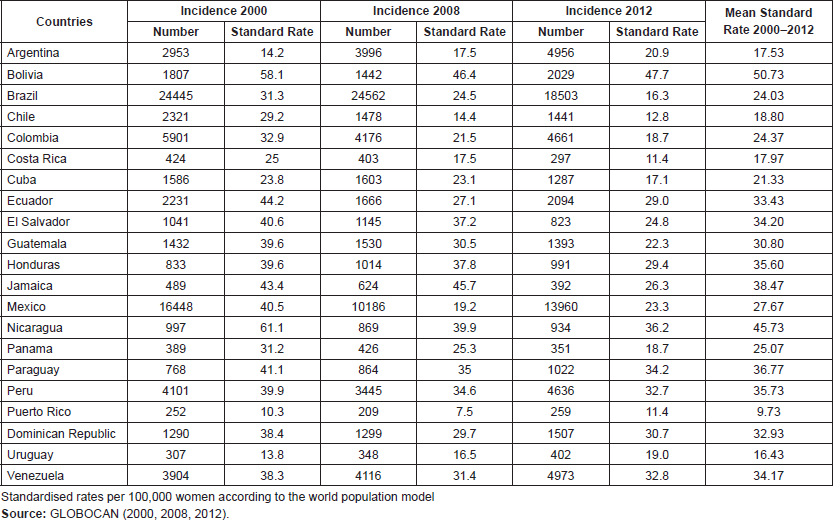

Figure 3. Cervical cancer. Standard rates. Incidence selected countries in Latin America 2000–2012.
Table 2. Mortality due to cervical cancer Latin America (2000, 2008, 2012).
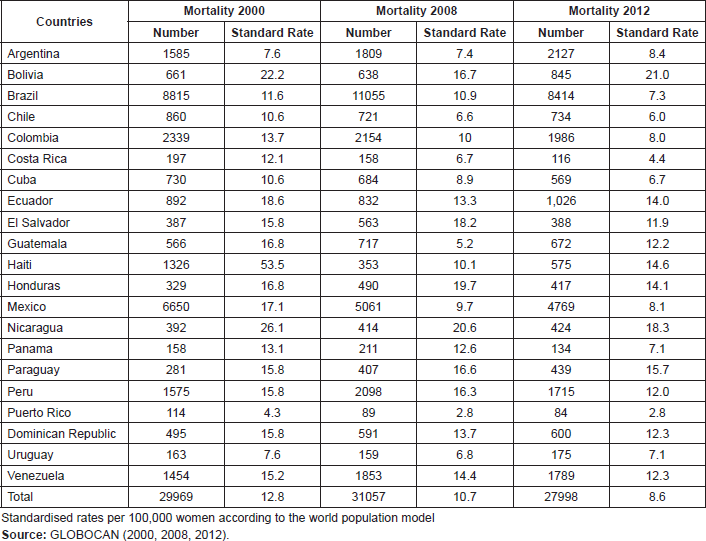
The incidence of cervical cancer in Latin America shows a tendency over time very similar to mortality; a marked variation can be seen between countries in Table 1 and Figure 3.
Individual factors include those variables linked to the personal characteristics of the women affected by the problem being studied. More than five decades of epidemiological evaluation has indisputably determined its relationship to the sexual habits of women and their partners; [4] as well as other characteristics, which constitute the risk profile associated with the greater probability of this cancer presenting in certain women [3].
A descriptive evaluation of the magnitude of the problem and its principal defining characteristics is shown below:
Magnitude of the problem
Along with the data mentioned in previous paragraphs and supported by tables, quantifying the significant scale of the problem by incidence and mortality figures, it would be useful to use a different social and economic disease indicator. Over the past few decades, years of potential life lost have been used for this. However, their calculation requires access to information on the age distribution of women with cervical cancer across all Latin American countries, which is fairly difficult to obtain.
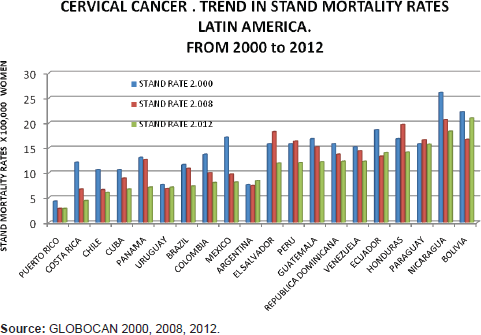
Figure 4. Cervical cancer trend in standard mortality rate from 2000 to 2012 in Latin America. Standard mortality rates X 100,000 women.
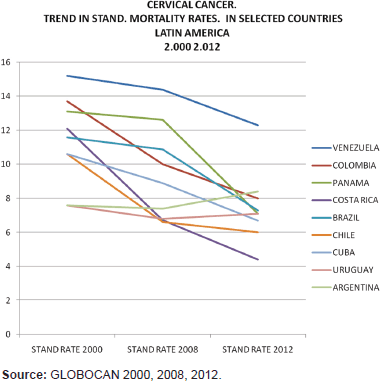
Figure 5. Cervical cancer. Trend in standard rates. Mortality selected countries in Latin America 2000–2012.
Other essential statistics are those relating to life expectancy among the female population in the countries analysed, which can be obtained from World Bank indicator reports [10].
To avoid the stated difficulties, a mathematical model was applied based on the assessment carried out over the course of more than 20 years monitoring the behaviour of cervical cancer in Venezuela. This has shown a marked stability in indefinitely maintaining an average age of death of 55 years and a fairly stable percentage distribution by age group, as is shown in Figures 6, 7, and 8.
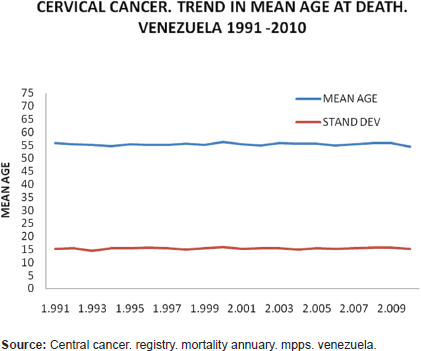
Figure 6. Cervical cancer. Trend in mean age at death. Venezuela 1991–2010. Mean age.

Figure 7. Cervical cancer. Percentage distribution of mortality by age group 1993–2010.
This allowed us to maintain the hypothesis, to be set out in a subsequent study, of similar behaviour in all other Latin American countries.
By applying the same percentage distribution by age at death for each country, it is assumed that the average age of death will equally be very close to 55 years. In our experience of analysing trends of mortality due to cervical cancer over a number of years, we have noticed that the average age is very close to the median in each annual series, which moreover have a pattern that approximates to a normal curve; consequently, taking the value of the average age at death and subtracting it from life expectancy would give us a value close to the average number of years of life lost by each death, and by multiplying this by the total number of deaths per period, we can estimate somewhat approximately the real number of years of life potentially lost, as shown in Table 3, which establishes for the region a loss of 633,000 potential years of life, especially in areas where the woman is the fundamental factor in a nuclear family.
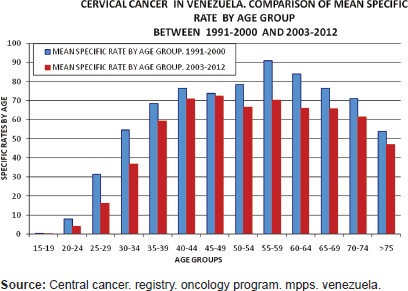
Figure 8. Cervical cancer in Venezuela. Comparison of specific rates by mean ages 1991–2000 versus 2001–2010. Specific rates by age groups.
Table 3. Cervical cancer in Latin America. Potential years of life lost in 2012.
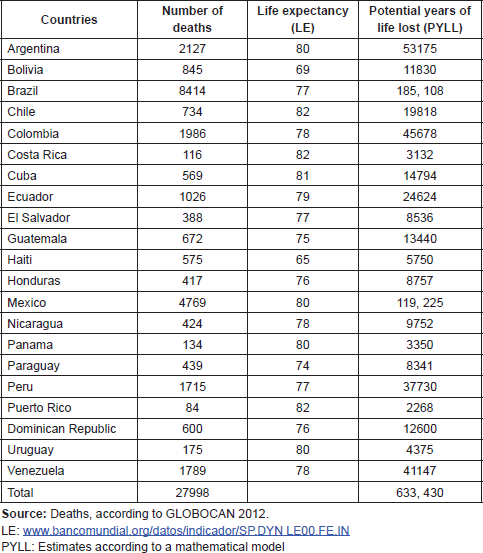
Knowledge of distribution by age group is determined by the design of control strategies, meaning that its constant monitoring is needed for detecting possible variations over time.
As previously stated, in Venezuela, monitoring has been maintained, based on incidence rates by age group, expressed in classes spanning 5 years, which we have maintained since 1980.
Very similar curves have been observed, rising rapidly from class 20–24, up to 45–49, with the ascent slowing up to 55–59; beyond this point, the incidence rate begins to decrease.
Figure 8 shows a comparison between the decades 1991–2000 and 2001–2006, during which periods a moderate decrease was seen in the rate of incidence, equally reflected across all age groups.
Therefore, this renders questionable the frequent affirmation by clinical specialists pointing to an increase in cases in younger women, which is simply an effect of population (larger current population in this age group means more cases, but not an increased risk, and still less a change in the natural history of this pathology).
As we have already shown, the average age of the cases and of death has remained stable in Venezuela (Figure 6) and there is a substantial enough basis for the stability of the natural history of this cancer [11] to suppose that the same must be happening in the rest of Latin America.
Demographic factors include illiteracy, poverty and poor hygiene practices, little access to health services or attention to investigatory programmes based on periodical smear testing. These factors are consistently linked to higher incidences of, and mortality due to, cervical cancer, from which comes the connotation that it is a third world cancer, or the view that a high mortality rate from cervical cancer is an indicator of underdevelopment, but it is certain that the impacts of these factors are given in determining the influence of risky sexual habits and the lack of timely and appropriate access to prevent and control measures.
Other factors, such as smoking habits, are indicated in various studies to be tied to an increased risk of cervical cancer, linked to a doubling of risk to women smokers and correlating positively to the greater intensity and duration of the habit [12]. The discovery of nicotine and the derivatives of tobacco smoke in cervical mucus, signalled by Schiffman, [13] suggest a possible biological mechanism through immune-suppression, which encourages infection by the HPV.
Nutritional deficiency is a risk factor which has been closely evaluated, especially in relation to its potential application in chemoprevention. Evidence based on epidemiological studies exists showing that nutritional deficiency, in particular in vitamins A and C, lead to increased risk of cervical cancer. In one International Agency for Research on Cancer (IARC) study, high- and low-risk regions are compared, and a decreased risk is shown in areas with increased consumption of vitamin C and beta carotene [14]. Other studies in Italy and the USA support these results [15].
A multicentre study of cases and controls did not find any relationship between increased risk and levels of carotenoids, vitamin A or vitamin C, measured through information on the consumption of 75 types of foods [16].
Over the course of many years, cervical cancer has been linked with sexual and reproductive factors. The first antecedents date from the observations of Doménico Rigoni-Stern in 1842 [17] who described his discoveries in a statistical investigation across a number of decades of cancer mortality in the population of the Verona region of Italy, which showed the absence of cervical cancer in nuns, and a greater incidence in married or widowed women than among single women; this was followed almost a century later by the publication of similar discoveries by Lebian Gagnon [18] in Quebec.
However, from the 1960 onwards, numerous works were published, many of which were included in the systematic revision by I D Rotkin [19] in 1973, aiming to identify an infectious agent which, by transmission through sexual contact, could be the cause of this type of cancer.
It was Harald Zur Hausen [20] who in 1983 identified the DNA of the HPV in the cancer cells in the cervix and subsequently with the epidemiological work of Nubia Muñoz, Xavier Bosh and Cols, [21] the hypothesis was confirmed, that is, that the persistent infection with types 16, 18, 58, 31, etc. of the HPV, constituted the necessary factor, although not sufficient for the development of this malignancy.
Acceptance of HPV as a necessary factor in the development of cervical cancer lends value to the description of other sexual factors that could play a complementary role; these include initiation of sexual activity at a young age, which could be characterised as being under 18 years old, and risky sexual habits, defined as having more than two partners over the course of a sexually active life, with whom the relationship lasted not less than three months, or similar sexual habits in the male partner.
The increased risk posed by initiation of sexual activity at a young age is attributable to immunological immaturity of the cervical epithelium which allows for a viral infection and not as a factor in itself.
Risky sexual habits are directly linked to the possibility of infection by one or a number of the high-risk forms of HPV. The particular distribution of cervical cancer in certain regions of the world, which show the very low levels of mortality associated with restrictive sexual habits, consistently reinforces the role of sexual factors.
New Guinea is one of the examples that can support this hypothesis. It is an island located to the north of Australia, whose western portion belongs to Indonesia, and hence, the majority of the population are practising Muslims and mortality rates are much lower than the eastern part, Papua New Guinea (Figure 1), an independent country where only a minority of the population belong to this religion; thus highlighting variations in sexual habits as the cause of the marked difference.
The natural history of cervical cancer has been recognised in the last four to five decades, without there have been major changes beyond differences in the nomenclature of precancerous lesions or the identification of the HPV as the necessary agent, but not sufficiently to have developed and evolved into a malignant neoplasm. The importance of understanding the natural history of this pathology is in its application to control measures. As can be shown in Table 4, pre-cancerous lesions can be detected 5 to 10 years before women become clinically symptomatic [11], thus identifying these lesions gives a good chance of arresting the development of the pathology.
Early detection monitoring procedures for cervical cancer or its precursor lesions have been in place for some time, ever since the early development of the Aurel Babes and George Papanicolou cervicovaginal cytology technique [22] and colposcopy developed by Hans Heinselman [23].
Cervicovaginal cytology has had a significant impact on the control of this disease, despite having numerous detractors. However, it is not a simple method, as in order to be effective, it requires a well-structured organisation, supported by a population-based programme and a health system with well-defined levels, with complete decentralisation of the regular collection of cytology samples at clearly defined intervals, and with a protocol based on the epidemiological knowledge and potential of the cytology method. It requires well-equipped cytopathology laboratories, capable of processing no fewer than 40,000 smears annually, with strict quality controls and sufficiently qualified staff; and it also needs clinics for referring cases (Cervical Pathology Clinic), located strategically and with trained staff, able to promptly assess and treat (if necessary) all cases identified by cytological testing, who must have been located, given an appointment and treated appropriately, according to the programme protocol.
It is evident from the above that it is not a simple method, and it is also clear that it can operate with good results on an “opportunistic” basis, as in the USA, but this is only possible in countries with a high income per inhabitant, with costs that are multiples of those of scheduled, population-based research, as has been demonstrated in Scandinavia, Great Britain and many regions of France, Italy or Germany [24].
Appropriate, regular, well-structured access to cytology has been the main factor in determining the difference between countries at high risk and those at intermediate or lower risk (Table 5). The knowledge, though limited, obtained from Pan American Health Organisation (PAHO) reports [25, 26] on the percentage of cytology cover in Latin American countries fits fairly precisely inside the epidemiological profile of countries at low risk with mortality rates below 10, countries at intermediate risk with rates of 10 to 15, and countries at high risk, above 15. Some countries do not report on their cytology cover, such as Puerto Rico, but this should be close to the average for the USA which is 80%. Others, such as Venezuela or Panamá, report only cover corresponding to the Ministry of Health, and the percentage should therefore be around 50%. This correlation, which provides a fairly good match between good rates of cytology cover and low mortality rates and vice versa, is why we have accepted that the most decisive risk factor in mortality due to cervical cancer is the absence of appropriate cytological testing.
Other detection methods, such as direct visualisation of the cervix with acetic acid (visual inspection with acetic acid: VIAA) or with iodine (visual inspection with Lugol’s iodine: VILI) carried out by nurses or trained technicians, have gained importance in recent years, and these may be an option in rural populations with an under-developed health system [27]. With the advent of molecular biology techniques applied clinically for the diagnosis of high-risk types of HPV, which offer promising prospects in the more efficient detection of high-grade intraepithelial lesions [28], and which are gaining ground as costs are falling, and which offer a greater potential for large-scale use, we will thus have tools that facilitate monitoring and reduce the huge health and socioeconomic burden represented by cervical cancer in Latin America.
Table 4. Cervical cancer. Natural history.

Table 5. Cervical cancer in Latin America. Correlation between mean mortality rate and cytological cover (2000, 2008, 2012).
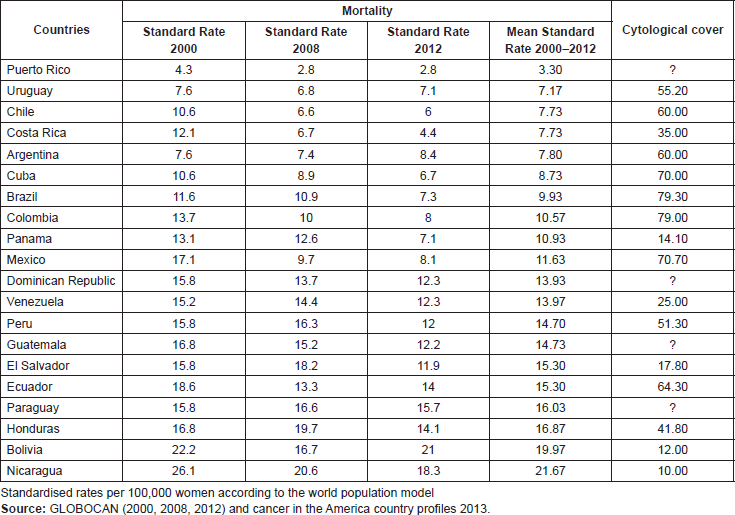
Vaccines against HPV
With the approval in 2006 of two vaccines against the high-risk HPV types 16 and 18 (which are present in 70% of carcinomas of the cervix) and their potential to reach types 31, 33, and 45 by cross immunity (which would provide approximately 10% additional protection), a powerful weapon is available for preventing approximately 85% of the risk of contracting cervical cancer in the coming years [29].
The majority of Latin American countries have begun HPV vaccination in recent years, but there is insufficient information available on the rates of cover achieved. Although appropriate vaccination levels have been reached, the impact of the effectiveness of the vaccine in preventing cervical cancer will not be observed for about 20 years. Screening procedures with the methods and adaptations specific to each region should therefore be maintained, along with efficient vaccination cover, to achieve effective control of cervical cancer in coming decades.
In an empirical mathematical model, which we use to measure the long-term impact of vaccination in Venezuela and on the premise that the current mortality rate remains stable or shows a slight downward trend, results would begin to be observed from the next 15 years onwards and the greatest impact would be achieved in about 30 years, as shown in Figures 9 and 10, which show a reduction of approximately 50,000 cases between 2030 and 2060, with a percentage reduction of 30.7%; a rapid fall in the number of cases should occur from 2060.
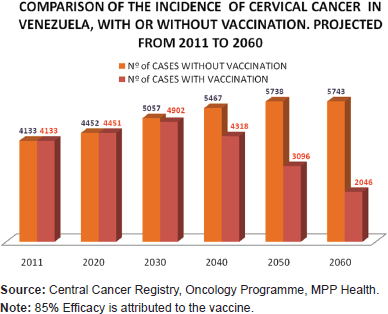
Figure 9. Comparison of the incidence of cervical cancer in Venezuela, with or without vaccination projected from 2011 to 2060. Number of cases without vaccination. Number of cases with vaccination.

Figure 10. Total expected cases of uterine cancer in Venezuela from 2030 to 2060 with or without vaccination. Number of cases without vaccination. Number of cases with vaccination. 33.7% reduction.
Conclusion
Cervical cancer has affected the human race for millennia and has wreaked havoc owing to its social and economic scale and impact, particularly in the disadvantaged regions of the world. The fight to control it has been slow; however, it is a clear example of how the development of medical knowledge in diagnosis, therapy, and prevention is paying off in terms of health.
The advent of vaccines to prevent infection by HPV types 16 and 18, which in worldwide studies have proved to be linked to 70% of the risk of suffering invasive cervical cancer and appear to have cross immunity for types 31, 33, and 45, as well as new research prospects involving low-cost procedures and potential widespread application for the detection of HPV risk types, suggest that the fight against cervical cancer is on the way to being won and that this achievement will undoubtedly have a key role in epidemiology.
References
1. Castellsagué X, Sanjosé de S and Aguado T et al (2007) HPV and Cervical Cancer in the World Report (www.who/icoinformationcentreonhpvandcervicalcancer)
2. Estrategia y Plan de Acción Regionales sobre la Prevención y el Control del Cáncer Cervicouterino (2008) (Washington DC: PAHO Publication) Available at: www.rho.org/files/PAHO_Regional_Strategy_2010_sp.pdf
3. Juneja A, Sehgal A and Mitra AB et al (2003) A survey on risk factors associated with cervical cancer Indian J Cancer 40(1) 15–22
4. Martin CE (1967) Marital and coital factors in cervical cancer Am J Pub Hlth 57 803–814 DOI: 10.2105/AJPH.57.5.803
5. Rotkin ID (1967) Epidemiology of cancer of cervix Sexual characteristics of cervical cancer population Am J Pub Hlth 57 815–829 DOI: 10.2105/AJPH.57.5.815
6. Solidoro A (2010) Pobreza, inequidad y cáncer Acta méd Peru 27 204–206
7. GLOBOCAN Available at: www.who./iarc/globocan
8. Drain PK, Holmes KK and Hughes JP et al (2002) Determinants of cervical cancer rates in developing countries Int J Cancer 100 199–205 DOI: 10.1002/ijc.10453 PMID: 12115570
9. Available at: http://www.paho.org/hq/index.php?option=com_content&view=article&id=9574:cervical-cancer-in-the-americas&catid=6648:fact-sheets&Itemid=40721&lang=en
10. Available at: www.bancomundial.org/datos/indicador/SP.DYN LE00.FE.IN
11. Holowaty P, Miller AB and Rohan T et al Natural history of dysplasia of the uterine cervix J Natl Cancer Inst 91 252–258 PMID: 10037103
12. Brinton LA, Schairer C and Haenszel W et al (1986b) Cigarette smoking and invasive cervical cancer J Am Med Ass 255 3265–3269 DOI: 10.1001/jama.1986.03370230071033
13. Schiffman MH, Halley NJ and Andrews AW et al (1987) Biochemical epidemiology of cervical neoplasia: measuring cigarette smoke constituent in the cervix Cancer Res 47 3886–3888 PMID: 3594446
14. Slatery ML, Abbiott TM and Overall JC Jr et al (1990) Dietary vitamins A, C and E and selenium as risk factors for cervical cancer Epidemiology 1 8–15 DOI: 10.1097/00001648-199001000-00004
15. La Vecchia C, Decarli A and Fasoli M et al (1988) Dietary vitamin A and the risk of intraepithelial and invasive neoplasia Gynecol Oncol 30 187–195 DOI: 10.1016/0090-8258(88)90023-6 PMID: 3371743
16. Ziegler RG, Brinton LA and Hamman HF et al (1990) Diet and the risk of invasive cervical cancer among white women in United States Am J Epidemiol 132 432–445 PMID: 2389748
17. Rigoni-Stern D (1842) Fatti statistici relativi alle mallattie cancrose che servirono di base alle poche cose dette dal doti G Servire Progr Pathol Terap Ser 2(2) 507–517
18. Gagnon F (1950) Contribution to the study of etiology and prevention of cancer of the cervix of the uterus Am J Obstet Gynecol 60 516–522 PMID: 14771140
19. Rotkin ID (1973) A comparison review of key epidemiological studies in cervical cancer related to current searches for transmissible agents Cancer Res 33(6) 1353–1367 PMID: 4352371
20. Zur Hausen H (1982) Human genital cancer: synergism between two virus infecctions or synergism between a virus infection and initiating events? Lancet vol II 1370–1372 DOI: 10.1016/S0140-6736(82)91273-9
21. Muñoz N, Bosh FX and de Sanjose S et al (2003) Epidemiologic clasification of human papillomavirus types associated with cervical cancer N Engl J Med 348(6) 518–527 DOI: 10.1056/NEJMoa021641 PMID: 12571259
22. Naylor B, Tasca L and Bartziota E et al (2002) In Romania it´s the Babes-Papanicolaou method Acta Cytol 46 1–12 DOI: 10.1159/000326708 PMID: 11843552
23. Hinselman H (1925) Verbesscrun der Inspecktionmöglickeiten von vulva, vagina and portio Münch Med Weshr 72 1733–1736
24. IARC (2005) Cervix Cancer Screening IARC Handbooks on Cancer Prevention vol. 10 Lyon France: IARC Press
25. Pan American Health Organization (2013) Cancer in the Americas: Country Profiles 2013, Washington, DC
26. Pan American Health Organization (2013) Cancer in the Americas Basic Indicators 2013, Washington, DC
27. Sankaranarayanan R and Wesley RS (2003) A practical manual on visual screening for cervical neoplasia Lyon, France: IARC Press
28. Blat A, Kennedy R and Luff R et al (2015) Comparison of cervical cancer screening results among 256,648 women in multiple clinical practices Cancer Cytopathol 123(5) 282–288 DOI: 10.1002/cncy.21544
29. Update on human papillomavirus (HPV) vaccines (2012) Canada Communicable Disease Report Vol 38 • ACS-1






